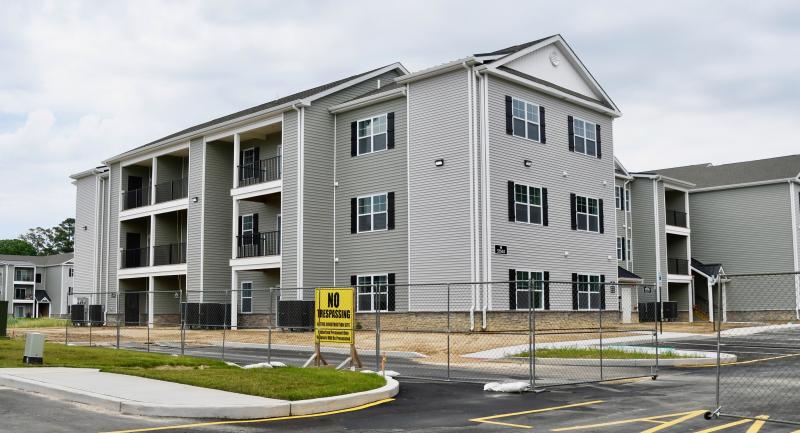Residents: Rental ordinance needs public hearings
Sussex County Council will have to decide whether or not public hearings are part of the proposed Sussex County Rental Unit Program ordinance. As it's written, only site-plan reviews are required. Residents who testified during a June 28 public hearing said hearings must be included.
While only a few residents spoke during the Sussex County Planning & Zoning Commission public hearing April 28, that was not the case during the council hearing.
Numerous speakers thanked county officials for taking the initiative to offer incentives to developers to build more workforce housing, but they also provided a laundry list of changes to the ordinance. At the top of the list was the proposal to eliminate hearings before planning & zoning commission and county council. Under the proposed ordinance, apartment and multifamily projects up to 12 units per acre in coastal areas, town centers and developing areas would be allowed to build by right without hearings. Developers would only need to submit site plans to the commission for review.
Other recommendations included making the ordinance a pilot program for one year, establishing a series of reviews, and a change to require DART bus stops at each project participating in the program.
At the end of the hearing, council voted to leave the record open for 14 days to accept written comments.
Gilmore: Time for action
“This is an important step. It's time to take action because the need is so great,” said Kevin Gilmore, CEO of Sussex County Habitat for Humanity. “We have to keep an eye on the goal and focus on solutions. We are closer to moving the needle to provide affordable units than we've been in decades. We can't afford to stop.”
Assistant county attorney Vince Robertson said the county has received correspondence from developers who said they will submit applications if the ordinance is approved.
Robertson said he feels confident, based on county housing data, that the program is financially viable.
The program has been in place since 2008, but only one project, Coastal Tide apartments near Lewes, has taken part in it.
Public hearings needed?
“Keep the public engaged,” said Jill Hicks, a Chapel Green resident. “Not allowing public hearings as part of the process is a grave mistake that will further exacerbate people's distrust in the county. It's a small price to pay for open communication for all parties involved.”
Hicks also suggested the ordinance should only reference workforce housing and not use the phrase affordable housing, which normally is government subsidized.
Patti Drago of Lewes said she understands public hearings are a barrier for affordable housing projects, but hearings are still critical to the process.
“You should create an administrative process to allow public comment. Transparency and trust are important to the success of the ordinance,” she said.
Instead of hearings, she suggested council could consider adding a 14-day period for the public to submit written comments on a proposed project.
She also said council should not amend the current bulk and design standards in the ordinance.
“We get good ideas and comments during public hearings,” said Councilman John Rieley. “The tradeoff is speed to market, because time is money.”
He said developers face uncertainty under the current land-use process that requires public hearings for multifamly housing. “It's a major hurdle to overcome,” he added. “The goal is more affordable housing.”
Rich Borrasso, Sussex Alliance for Responsible Growth spokesman, said the organization agrees that public hearings should be part of the process. “There have been many time and money references, but consider the impact to other stakeholders,” he said. “From the comments made today, you can see how important public input is.”
Borrasso said the time lag and uncertainty for developers on whether an application will be approved is determined by council. “If there are time delays, perhaps you are doing it for the right reason,” he said.
Councilman Mark Schaeffer reminded those in attendance that while the ordinance requires site-plan review only by the planning & zoning commission, projects are still subject to state agency review under the Preliminary Land Use Process, and state and county agency reviews of projects for permits and approvals.
Projects within the Henlopen Transportation Improvement District would be required to pay a fee per unit for road improvements.
P&Z recommends approval
The planning & zoning commission voted 3-2 June 9 to recommend approval of the ordinance with the following suggested changes:
• Include commercial area as a land designation where the ordinance applies
• Reduce the open space requirement from 50% to 30%
• Amend the setback requirements to 50 feet for buildings that do not exceed 42 feet and retain the 100-foot setback for buildings that exceed that height
• Amend the DART bus route requirement so that development can occur in a location where DART certifies in writing that a bus route will be established within three years from the date of the final site plan. The ordinance requires a bus route within one-half mile of a development before construction can begin.
Bus stops, not routes
Several speakers noted that the requirement for projects to be within one-half mile of an existing DART bus route should be changed to a requirement for a bus stop at the entrance to a community.
Drago said DART should commit in advance to a bus stop. “I don’t see too many people walking one-half mile to a bus stop,” Drago said.
Hicks said bus stops should be required before residents move into an apartment complex. “It should not be based on a promise by DART,” she said, adding that sidewalks, trails, shoulders and street lighting should be required to provide safe access to bus stops.
Review and oversight
Kate Mallard of Lewes, who is advocacy chair of the Sussex County Housing Group, was among those who suggested a review period and creation of an oversight mechanism to ensure the ordinance meets all criteria in the 2018 comprehensive plan. She also suggested housing vouchers be included.
“Commissioner [Keller] Hopkins said this ordinance is a gift to developers, and many people agree,” said Eul Lee of Lewes. “Once given, it's nearly impossible to get it back. Whenever you give something, you have to be very cautious.”
Lee, who provided a PowerPoint outlining her concerns, said the county should maintain oversight over the program and not leave it to a management company.
What's in the ordinance
At least 30% of the units must be set aside as affordable units as defined by the ordinance; density at 12 units per acre; open space of 50%; 100-foot perimeter buffers; connection to central water and sewer service; within one-half mile of a DART bus stop; building height limit of 52 feet, which is 10 feet higher than what is allowed today; interconnectivity to any adjacent commercially zoned properties; sidewalks on all streets with connectivity to surrounding sidewalks; walking and biking trails must be interconnected and are permitted with the buffer area.
But as commissioners and those who testified pointed out, the overriding factor in the ordinance is the provision that up to 12 units per acre is considered a by-right permitted use in all residential districts within the coastal, town center and developing areas. Public hearings before the commission and county council would not be required. Developers would only have to submit site plans for the commission's review.
The affordable units would be available to qualified renters whose annual income is 80% or less of the county's average median income.
Brandy Nauman, director of the county's Department of Community Development and Housing, said for a two-person family, the income level would range from $18,000 to $48,000. As an example, she said, monthly rents for units in the program in the Coastal Tide apartments are $590 for one-bedroom units, $705 for two-bedroom units and $815 for three-bedroom units.
See more at sussexcountyde.gov/sussex-county-rental-program.





















































